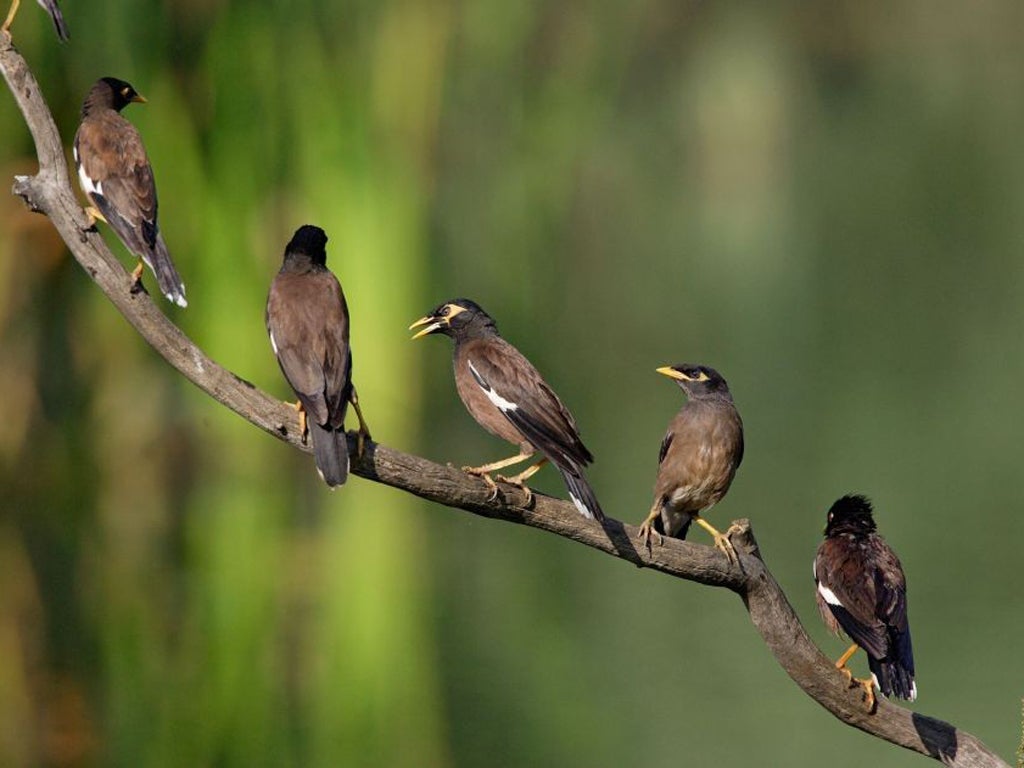Nature Studies by Michael McCarthy: In a birder's paradise, I thrill to the sight of a myna

Mynah birds (then spelt with a final h) were once popular in Britain in the days when every other family had a budgie in a cage and antimacassars on the back of the sofa; their ability to imitate human speech was regarded as equal to that of parrots. Cor. What a larf. They disappeared from British domestic parlours a long time ago but I have been watching them in the wild in the past week, while covering the UN Climate Conference in Durban, South Africa.
Southern Africa is a birder's paradise, with species to take your breath away, and if you ever catch sight of a lilac-breasted roller, as I did once in Namibia, you will need no convincing. But you can't do a lot of birding at a UN conference, because, if you shoot off somewhere with your bins, you're likely to miss the latest text from the Ad Hoc Working Group on Long-Term Cooperative Action, so you have to make do with what's around. And the mynas (no final h these days) are one of three local species I have managed to grab a look at in the gaps between waking, conferencing and sleeping, two of which were fascinating, and the third of which made my spirits lift.
The common or Indian myna is not, in fact, a native African bird but was introduced to what is now KwaZulu Natal a century ago, perhaps by Natal's large Indian community (Mahatma Gandhi being its most famous member). It's like a big starling, and indeed is in the starling family: a brownish job, with attractive white wing bars in flight, a yellow eye, and long yellow legs on which it stalks around with a swaggering strut.
It looks like a bully and it is, depriving other birds of their nest holes; and, as it adapts very well to human habitation and reproduces quickly, it has come to be regarded as a pest for tendencies such as roosting in trees and pooing on the cars parked below. I've been clocking it around the conference centre, and in the Durban suburb where I've been staying, and, although you would think it common as muck if you lived here, its unfamiliarity to me has made it an enjoyable sight.
A much more surprising sight in my suburb has been the hah-de-dah. I spell it that way because that's how you pronounce it, and, when I first heard it spoken of, I thought for a moment it was the lah-de-dah, which would be a most memorable name for a bird, would it not? But it's actually spelt hadeda, and it's an ibis.
You know ibises; those big wading birds with downward decurved bills which figure in Egyptian hieroglyphics. They look fantastically exotic, and to see four of them on a small suburban lawn, probing the grass for worms 10 yards from the French windows, nearly as big as sheep, makes your eyes pop out.
But that's what they do: hadedas, like mynas, have adopted to human habitations and they are the blackbirds of suburban Durban, 50 times bigger. (The landlady of the guest house next door told me they steal her dogfood.) Their loud cries, which are meant to be represented in the name, but aren't really, have awakened me each morning at 6am, yet I don't mind, because I can see dawn breaking over the distant Indian Ocean.
The third bird I have been looking at is only too familiar: the swallow. By that, I mean our swallow, the European swallow, officially the barn swallow, Hirundo rustica. I've seen three of them, streamlined navy blue blurs, and they have vividly brought to mind one of the most memorable moments in ornithology, recounted left.
The little symbol of home and its 12,000-mile round trip
People had known for centuries that swallows migrated from Britain in the winter, but nobody had any idea it was as far as to South Africa, 6,000 miles way, until a Staffordshire solicitor, John Masefield, ringed a young bird in the porch of his home in May 1911. Just over 18 months later, on 23 December 1912, it was recovered on a farm near the small Natal town of Utrecht, about 150 miles north of Durban, proving that these matchbox-sized birds made this scarcely believable journey twice a year.
I have been looking northwards, longingly, towards Utrecht, dreaming that I might nip up and find the farm, if it is still there. (It was called "Roodeyand" and the farmer was a Mr Mayer). There has been no time; but the sight of the swallows themselves has been enough – European swallows here for the winter, looping, swooping, curving through the air, each one seeming a piece of our spring, waiting to come back to us.
Subscribe to Independent Premium to bookmark this article
Want to bookmark your favourite articles and stories to read or reference later? Start your Independent Premium subscription today.

Join our commenting forum
Join thought-provoking conversations, follow other Independent readers and see their replies